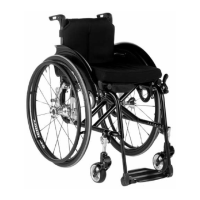1 Foreword
INFORMATION
Date of the last update: 2013-08-12
► Please read this document carefully.
► Follow the safety instructions.
INFORMATION
Missing instructions for use or service manuals can be downloaded from the homepage at www.ottobock.com.
Missing instructions for use can also be ordered directly from the manufacturer's service department (see back
cover or inside back cover for addresses).
Initial adjustments to the product were made according to the order form. Nevertheless, fine adjustment may be
required and settings may have to be made according to the medical conditions or the user's requirements.
These instructions for use provide the information necessary for adjusting the settings. This work should be closely
coordinated with the user.
Please note the following:
• The instructions for use (qualified personnel) are intended only for qualified personnel and remain with them.
• The operation of the product and functionality of the options are described in the instructions for use (user).
These instructions for use must be given to the user.
• Children and youths must be instructed in the use of the product by you or an attendant using the instructions
for use (user).
• The manufacturer recommends checking the product settings regularly in order to assure an optimum fit over
the long term. A review is required every six months for children and youths in particular.
• The installation and retrofitting of all optional components are generally described in the service manual.
2 Application
2.1 Intended Use
The wheelchair is intended solely for everyday indoor and outdoor use by people who are unable to walk or have a
walking impediment and can be operated by the patient or another person.
The wheelchair may only be used with the options listed in the product order form.
Ottobock assumes no liability for combinations with medical devices and/or accessories from other manufacturers
not included in the modular system.
2.1.1 Special features of Avantgarde CLT
In the welded version, the Avantgarde CLT has a welded fitting for mounting of the rear wheel and a welded back
rest. In this weight-saving version, the rear wheel and backrest height cannot be subsequently adjusted. Further
more, installation of certain options (e.g. anti-tipper) is not possible.
For these reasons, this wheelchair version is intended only for experienced users with sporting ambitions who,
thanks to their physiological capabilities, are able to handle the wheelchair proficiently. Before supplying this ver
sion, the user should be examined intensively for suitability (adequate physiological capabilities).
2.2 Indications
The broad range of equipment options and the modular design allow the wheelchair to be used by people who are
unable to walk or have a walking impediment, for example due to:
• Paralysis (paraplegia, tetraplegia)
• Loss of limbs (leg amputation)
• Defects or deformation of the limbs
• Joint contractures or damage
• Neurological and muscular diseases
• Disorders such as cardiac or circulatory insufficiency, equilibrium disturbances or cachexia as well as geriatric
patients who still have usable residual strength in the upper limbs.
The wheelchair was designed in particular for individuals who are generally able to move around actively and
freely in the wheelchair.
Ottobock | 5Avantgarde CV/CS/CLT
Foreword

